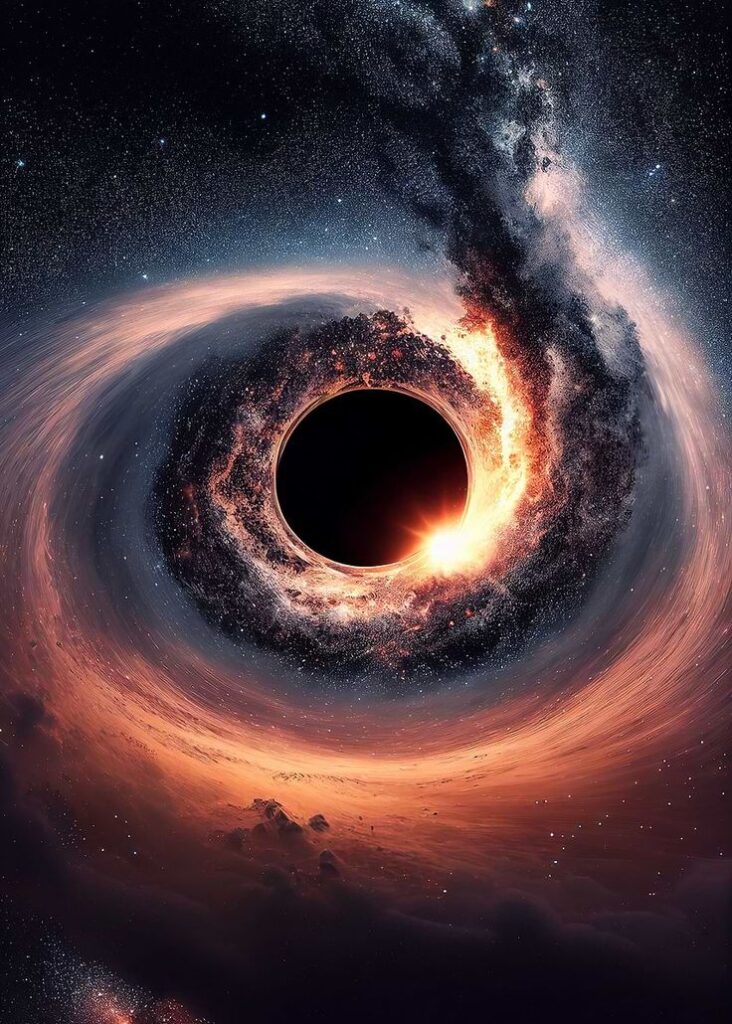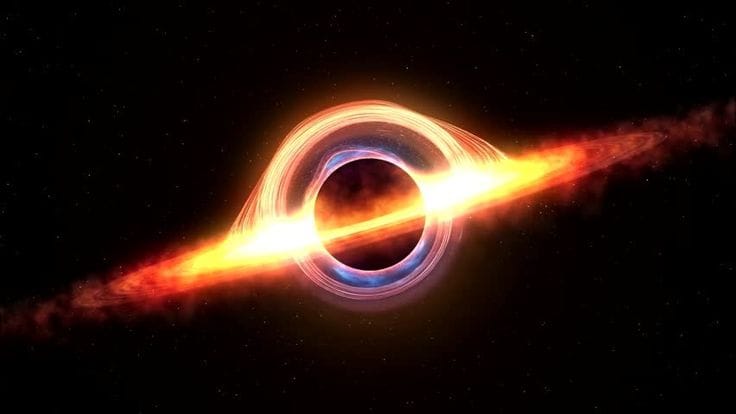Black holes and space-time fascinate scientists and dreamers alike. These cosmic giants twist space and time, hiding secrets of the universe. Let’s explore how black holes shape reality.
What is a black hole and how do they form?
A black hole is a region in spacetime where gravity pulls so strongly that nothing escapes. Massive stars collapse under their own gravity and form a black hole with a dense core. The center of the black hole compresses matter infinitely. Surrounding it lies the event horizon of the black hole, marking the boundary of no return. Einstein’s relativity predicted the existence of black holes through extreme gravitational effects.
What are the different type of black holes?
There are several types of black holes, mainly classified by their mass of the black hole. Small black holes form from collapsed stars, while supermassive black holes exist at galaxy centers. Other forms include rotating black holes and charged black holes. Each type affects space and time differently due to their gravity of the black hole. Scientists also study binary black holes that orbit and merge.
How does a supermassive black hole differ from other black holes?
A supermassive black hole contains millions or billions of solar masses, unlike smaller types. It usually sits at a black hole in the center of galaxies, including our Milky Way. Its enormous black hole’s mass creates extreme gravitational fields influencing stars and gas around a black hole. Despite its size, the event horizon still marks the limit of escape. Its gravity shapes galaxy evolution uniquely.
Did you know the first image of a black hole was captured in 2019 by the Event Horizon Telescope?
What processes lead to the existence of black holes?
The existence of black holes starts when massive stars burn out fuel and collapse under gravity. This collapse compresses matter into a dense point in space, creating a real black hole. The surrounding event horizon traps light and matter forever. Sometimes, collisions of neutron stars or gas clouds also contribute to black hole formation. Einstein’s equations describe this process in general relativity.
How does time and space behave near a black hole?
Near a black hole, time and space warp severely due to intense gravity. This extreme gravitational field of the black hole distorts distances and slows down time, a phenomenon called time dilation. As you get closer to the black hole, space compresses and light bends sharply. The nature of space and time breaks down near the event horizon of the black hole. These effects confirm Einstein’s relativity.
Read about What time is it on the moon
What is the significance of time dilation near a black hole?
Time dilation near a black hole means time passes slower compared to far away from it. The intense gravity of a black hole stretches the time dimension, affecting clocks and signals. This effect becomes extreme at the event horizon, where time almost stops from an outside view. It helps scientists test general relativity and understand how gravity influences space and time.
How does gravity affect time inside a black hole?
Inside a black hole, the gravity of the black hole warps time inside a black hole so severely that all timelines collapse inward. The amount of proper time experienced by an object falling changes dramatically. The second law of black hole mechanics connects gravity to entropy and time flow. The physics inside remains a mystery, as inside the black hole, normal rules no longer apply.
Did you know time slows down near a black hole due to extreme gravity, causing significant time dilation?
What happens as you get closer to the black hole?
As you get closer to the black hole, gravity strengthens and stretches space and time. The gravitational field of the black hole grows, causing tidal forces that can tear objects apart. Approaching the horizon of the black hole means crossing the event horizon, where escape becomes impossible. Space bends so much that light paths curve inward. The closer you get, the more extreme the distortion.
What can we learn about spacetime from black holes?

Black holes provide a unique window into the nature of space and time. Their extreme gravity distorts spacetime, confirming predictions from general relativity. Studying them reveals how mass and energy curve the universe and affect time flow. Phenomena like time dilation and event horizons illustrate the fabric of the cosmos. Black holes also challenge our understanding of physics at singularities.
How do black holes help us understand relativity?
Black holes serve as natural laboratories for Einstein’s relativity, demonstrating gravity’s power over space and time. Their strong fields test predictions of gravitational waves, time dilation, and light bending. Observations of binary black holes merging confirm aspects of relativity’s dynamic spacetime. Black hole mechanics laws deepen our grasp of entropy and energy in relativistic settings.
What is the role of the event horizon in spacetime?
The event horizon defines the point where gravity prevents anything from escaping the black hole’s pull. It marks a boundary in spacetime separating inside from outside. Crossing the event horizon into the black hole means losing causal contact with the outside universe. The horizon acts as a one-way membrane and shapes the black hole’s observable properties. It is key in black hole solutions to Einstein’s equations.
What does crossing the event horizon mean for an observer?
For an outside observer, crossing the event horizon of the black hole appears to freeze in time due to time dilation. For the falling observer, crossing happens in a finite amount of time, with no sudden effects at the horizon itself. Beyond this boundary, all paths lead to the centre of the black hole. The observer cannot escape, as the gravity of the black hole pulls everything inward relentlessly.
Did you know binary black holes emit gravitational waves, ripples in spacetime detected by LIGO?
What happens inside a black hole?
Inside the black hole, conventional physics breaks down near the center of the black hole, known as the singularity. The gravity of a black hole compresses matter infinitely, warping spacetime beyond understanding. Time and space reverse roles, and all paths lead inward. We cannot observe inside the black hole, as information cannot escape the event horizon. This area remains a major scientific mystery.
What is the center of the black hole like?
The center of the black hole, or singularity, is a point where density and gravity become infinite. It collapses all matter and energy into zero volume, breaking known physical laws. The entropy of a black hole relates to information lost at this center. Because of extreme gravity, time and space lose their meaning here, marking the ultimate limit of our understanding.
Can we observe phenomena inside a black hole?
No, we cannot observe phenomena inside a black hole because the event horizon blocks all light and signals. Anything that crosses the horizon cannot send information outside. Therefore, the picture of a black hole only shows effects outside the black hole. Observations rely on gravitational waves and radiation from material near the horizon.
What are the implications of falling into a black hole?
Falling into a black hole means facing intense tidal forces that stretch and compress objects. The gravity of the black hole grows stronger, pulling everything towards the singularity. Time slows relative to outside observers, causing extreme time dilation. Once past the event horizon, escape becomes impossible, and the fall leads inevitably to the centre of the black hole.
How do black holes affect their surroundings?

Black holes influence nearby stars and gas through their gravitational field of the black hole. Their strong gravity can pull in matter, creating accretion disks that emit intense radiation. The mass of the black hole governs the size of the affected area. In galaxies, supermassive black holes regulate star formation and galaxy dynamics, shaping cosmic evolution.
Read also about What Is the Speed of Earth?
What is the impact of a black hole’s mass on nearby stars?
The black hole’s mass determines its gravity of the black hole and affects the orbits of nearby stars. Massive black holes can accelerate stars to high speeds or even capture them. The gravitational influence causes tidal forces that may disrupt star clusters. Studying these motions reveals the black hole’s size and presence in galactic centers.
How do binary black holes interact with each other?
Binary black holes orbit each other, emitting gravitational waves as they lose energy. Over time, these waves cause the black holes to spiral closer and eventually merge. The merger creates a more massive black hole and a burst of spacetime ripples detectable by instruments. Studying these events tests Einstein’s relativity and black hole mechanics.
What observations have been made around a black hole?
Astronomers observed accretion disks, jets, and stellar motions around a black hole using various telescopes. The first image of a black hole captured by the space telescope Event Horizon Telescope showed the glowing matter near the horizon. Gravitational wave detectors recorded mergers of binary black holes, confirming theoretical predictions about black holes in general relativity.
What are the latest discoveries about black holes?
Recent discoveries include detecting gravitational waves from merging black holes and observing gas behavior near supermassive black holes. Scientists found the closest black hole to Earth, improving our understanding of black hole populations. The space telescope continues revealing phenomena like rotating jets and time distortions, deepening knowledge about black hole physics.
How has the space telescope contributed to our understanding?
The space telescope provided the first image of a black hole, confirming its shadow and event horizon’s shape. It captured detailed views of accretion disks and jets, clarifying black hole energy emissions. The telescope helped measure black hole masses and spin rates, improving black hole solutions in relativity. NASA science missions continue expanding black hole research.
What new theories have emerged regarding black holes may affect the universe?
New theories suggest black holes could influence cosmic expansion through dark energy or be gateways to other universes. Concepts like the entropy of a black hole link gravity and quantum mechanics, hinting at unified physics. Hawking predicted black holes emit radiation, slowly evaporating over time. These ideas challenge traditional views of the universe’s fate.
What are scientists hoping to learn about black holes in the future?
Scientists aim to uncover mysteries inside the event horizon, understand singularities, and unify gravity with quantum theory. They seek to learn how black holes grow and shape galaxies. Future observations of gravitational waves and black hole’s gravity effects may reveal new physics. Ultimately, they hope to solve puzzles about the nature of space and time through black holes.
Frequently Asked Questions about Black holes and Space-time
How do black holes affect space and time?
Black holes distort spacetime intensely due to their immense gravitational field. Near a black hole, space and time bend, causing effects like gravitational time dilation and the warping of the time dimension. This distortion reveals the deep link between gravity and the nature of space and time.
Do black holes affect space-time?
Yes, black holes dramatically affect spacetime by creating a strong gravitational field that curves space and slows time near the event horizon. This curvature influences the path of light and matter around a black hole, illustrating key properties of black holes in general relativity.
How long is 1 minute in a black hole?
Inside a black hole, the concept of time changes drastically. Due to the black hole’s gravity, an outside observer sees time near the event horizon slow down infinitely. For an object falling into the black hole, the amount of proper time until reaching the center of the black hole is finite, but time inside a black hole’s event horizon behaves unpredictably.
Black holes challenge our understanding of space and time. What mysteries would you want to uncover about these cosmic puzzles? Share your thoughts and keep exploring!
Read also about what is the time on mercury